Warning: These are advanced tables and only should be altered by experienced tuners.
Honda Knock Control
Honda knock control is designed to cope with different quality fuel in a stock engine. It is important to remember these design parameters when tuning the knock control to suit your engine.
The knock control method Honda uses can seem complicated, but it helps to understand how an engine is tuned from the factory. All tuning is performed on an engine dyno using an automated process which tunes every location in each table. For VTC engines this includes each cam angle table as well.
| 1. | Using a (very) high octane fuel, the engine is tuned to find the ignition timing which makes the most power. This is called 'mean best torque' (MBT) ignition timing. |
| 2. | Using 100 octane (RON) fuel, the engine is tuned to find the maximum spark advance before any knock is likely. This is called the 'knock ignition limit'. |
| 3. | Using 90 octane (RON) fuel, the engine is tuned to find the maximum spark advance at this octane. This gives the low octane knock limit ignition advance. The reason 90 and 100 octane is used (approx 85 and 95 octane r+m/2 method) is because this is the likely range of fuel octane the engine will used with. |
An example graph showing ignition timing for a single rpm point:
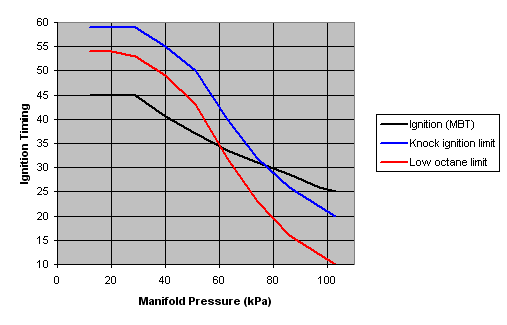
The normal ignition tables contain MBT ignition advance values (black line above). An additional table contains the knock ignition limit values (blue line above). It is possible for the knock ignition limit to be lower than the MBT timing. In this case, the ECU will use the lower of the MBT timing and knock ignition limit timing so that the engine will make the most power possible, but will not knock. eg at 80 kPa manifold pressure the ignition table contains 30º, but the most timing the engine can run is 28º (from the knock ignition limit table). Thus the ECU may run less timing than the ignition tables at certain load/rpm points, even if it does not detect noise from the knock sensor. Note that this will not show as 'knock retard', as the ECU considers this to be a 'no knock' condition.
Actual ignition timing used (green line):
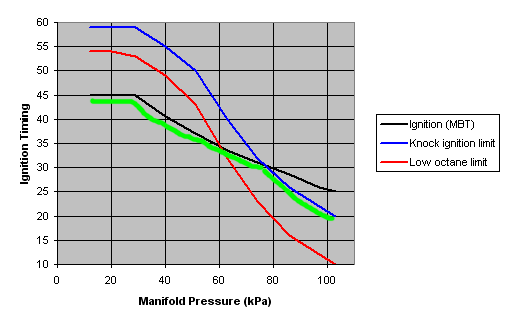
The ECU has the ability to retard the ignition further if it determines that knock is occurring. From the amount of knock sensor noise, and knock sensitivity, the ECU adjusts a 'knock control' ( or 'K.Control') variable. Nominally the 'knock control' contains the estimated fuel octane, as a percentage of the difference between 100 and 90 octane. eg a value of 0% means the ECU considers the fuel 100 octane or above, a value of 25% means the ECU considers the fuel to be 97.5 octane. The K.Control is dynamically adjusted at a fairly slow rate while driving.
If K.Control is greater than 0% and the maximum ignition timing is less than the MBT timing then the difference between the knock ignition limit and maximum ignition timing will show as a knock retard value.
Actual ignition timing used (green line) with a knock control of 50%:
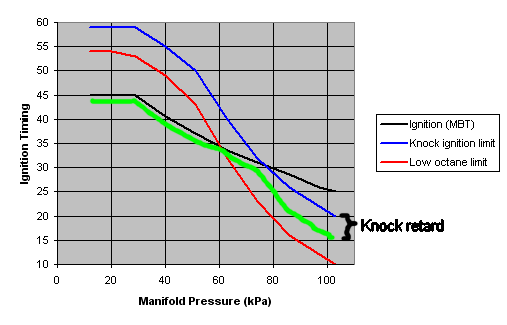
The ignition timing calculation is:
Ignition advance = minimum(MBT Ignition, MBT Ignition + knock ignition limit - (knock retard x knock control))
Knock Tables
Knock Ignition Limit Tables
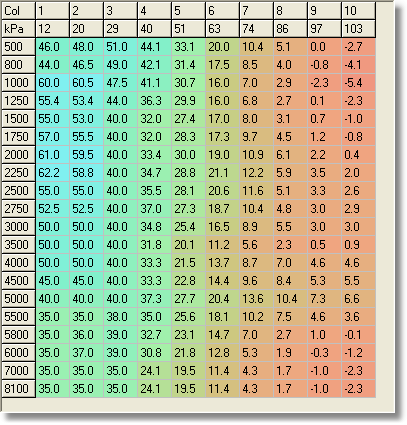
The knock ignition limit table contains the maximum ignition advance before knock is likely. Note that this value is relative to the ignition table. A positive value indicates that the knock limit is higher than the (MBT) ignition table value; a negative value indicates that the knock limit is lower than the (MBT) ignition table value, and normally the ECU will retard the timing by the negative value.
Caution should be exercised when changing the knock ignition limit table - if any negative values are increased (ie made closer to zero or made positive), then the ECU will advance the ignition by that amount.
Knock Air Limit Table

Sets the cylinder filling limit (mg) based on knock retard. Can be increased without adversely affecting K.Control. Makes boost levels more consistent as knock retard varies.
Knock Sensitivity Tables
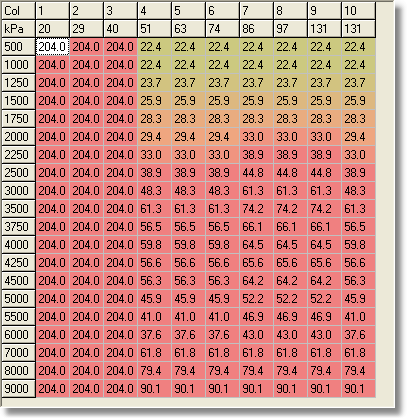
The knock sensitivity tables set the amount of noise from the knock sensor which the ECU will accept before it determines that the engine is knocking. A low value will increase the sensitivity to knock sensor noise/
Knock Retard Tables

The knock retard table contains the amount of knock retard, in degrees, between the high octane and low octane knock ignition limits. The actual amount of knock retard the engine applies will depend on the knock control value. eg a knock control value of 50% will give half the knock retard from the table. Note that the ECU will only retard timing if the (dynamic) knock ignition limit is less than the (MBT) ignition value.
Tuning Knock Control
Again, the Honda knock control is only designed to compensate for different quality fuel. It will not (quickly) actively retard and advance the ignition as some other make vehicles will do. If you de-sensitize the knock sensor by adjusting the knock sensitivity table because of noisy cams, don't expect the knock control to detect knock reliably.
Because we cannot tune all the ignition, knock limit and knock retard tables in an automated fashion with spec fuels, we must use some rules of thumb when tuning these tables. These are our tuning recommendations:
| • | Main ignition tables - decrease the ignition timing in the main (MBT) ignition tables at rpm and load points where the knock ignition limit tables are negative. This will then allow us to use the factory knock control more effectively. |
| • | Knock ignition limit - use low values where the engine is likely to knock. For forced induction engines on pump fuel we can assume they are tuned to the edge of knock, so columns 9 to 10 and should be 5 degrees or less, and columns in boost should be zero. Note that you should always adjust the main ignition tables if increasing values in the knock ignition limit table. |
| • | Knock sensitivity - increase the knock sensitivity (reduce the values) in columns 4 and above. For engines with noisy cams, headers etc, you may need to reduce the sensitivity (increase the values). |
| • | Knock retard - use a smaller knock retard than stock - 4 to 10 degrees. The lower columns (6 and below) will have little effect on knock retard as the knock ignition limit should be much higher than the MBT ignition timing in these areas. |
| • | Knock control - on newer vehicles, knock control will start out high and slowly come down as the engine runs through normal driving conditions. You can expect close to full knock retard right after programming the ECU. To decrease knock control on the dyno, simply hold the car at a steady RPM and, as long as there is no pinging, the knock control will gradually come down. |